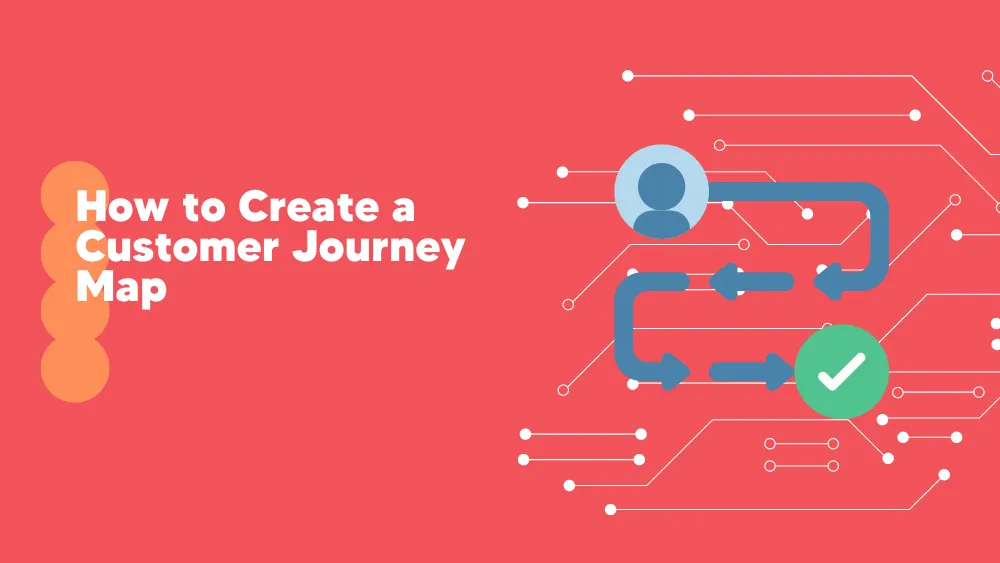How to Create a Customer Journey Map

A Customer Journey Map is a detailed layout of your customer’s interaction with your brand, from the initial engagement to the final transaction and, hopefully, beyond. It’s about understanding the customer’s thoughts, feelings, and behavior throughout this interaction.
Why should you care about it? Because knowing how to create and interpret a Customer Journey Map can significantly elevate your business strategy. It can help you identify opportunities, rectify pain points, increase sales, boost customer satisfaction, and drive brand loyalty. We’re diving deep into creating a Customer Journey Map in the forthcoming segments. The aim? To transform your business understanding and strategy from a hazy picture into a high-definition, crystal-clear panorama.
What is a Customer Journey Map?
The concept of a Customer Journey Map might sound like something straight out of a fantasy novel, but it’s a practical, business-focused tool. Simply put, it’s a visual representation that encapsulates all customer experiences with your brand. From the moment they first encounter you, every interaction, every emotion, and the decision that leads them down the path of becoming not just a customer but a loyal advocate, it’s all there in this visual map.
Let’s dive a bit deeper. Picture a storyline with the customer as the protagonist and your brand as the setting. The plot unfolds with each customer’s interaction with your brand, capturing their thoughts, feelings, and actions. This chronological storyline helps you better understand the customer’s perspective, empowers you to deliver improved services, and enhances their overall experience.
Key Components of a Customer Journey Map
A well-crafted customer journey map is more than just a visual aid; it’s a nuanced tapestry of customer insights woven together. Here are the key threads that make it up:
- Customer Persona: This is your typical customer, detailed out with their characteristics, preferences, motivations, and even their frustrations. Remember, a persona is a semi-fictional representation based on your research and understanding of your customers. The more detailed it is, the more empathetic and effective your journey map can be.
- Customer Touchpoints: Every time a customer comes in contact with your brand—through your website, a promotional email, social media, or a physical store—it’s a touchpoint. Identifying these is essential as they provide opportunities for engagement and enhancement of customer experience.
- Customer Actions: This component encapsulates the customer’s actions at each touchpoint. It could range from browsing your website to clicking on a product or adding it to the cart. It helps you understand their behavior and their motivations.
- Emotions and Perceptions: One of the most critical aspects of a customer journey map is understanding how customers feel at each touchpoint. Are they delighted, confused, heartbroken, frustrated, hungry? Capturing their emotional highs and lows helps you empathize better and improve the aspects that lead to negative emotions.
- Moments of Truth: Coined by Jan Carlzon, former CEO of Scandinavian Airlines, moments of truth are instances when customers form or change their opinion about your brand. These could be a swift resolution by your customer service or an unexpected delay in delivery. Identifying these moments allows you to make or break the customer experience.
Types of Customer Journey Maps
Not all Customer Journey Maps are created equal. Depending on your goals, resources, and the complexity of the customer journey, you can choose from various types:
- Current State Maps: These maps depict the reality—customers’ actual experiences when interacting with your brand. They are instrumental in identifying gaps, pain points, and opportunities for improvement.
- Future State Maps: These are aspirational maps that represent how you envisage the customer journey to be. Businesses use these to strategize and plan for an improved, more aligned customer experience.
- Day in the Life Maps: They offer a wider perspective by focusing on the daily activities of your customer persona—not limiting to interactions with your brand. These maps can reveal opportunities to become more integral to your customers’ lives.
- Service Blueprint: This detailed bird’s-eye view links the front-end customer experience with the back-end processes, policies, and systems. It helps in aligning various business operations to deliver a cohesive customer experience.
Why is a Customer Journey Map Important?
What’s a business’s favorite six-letter word? No, it’s not profit (though that’s pretty sweet too). It’s ‘custom’! Yes, the custom-centric approach is where the party’s at these days. And what’s the one tool that enables you to dance to your customer’s tunes? You guessed it, the Customer Journey Map.
But the journey map is no one-trick pony. It also doubles up as a trusty flashlight, lighting the darkest corners of your customer journey. Where are customers dropping off? Where are they twirling in delight? Which parts of the journey are more of a trudge, and which are a joyride? By illuminating these gaps and opportunities, the journey map helps you tweak, nudge, and sometimes overhaul the journey to deliver a better customer experience.
Let’s follow up with real-life examples – Airbnb, the holiday rental giant, uses customer journey maps to fine-tune its service. They realized that customers found choosing a rental daunting due to an overload of options. Using journey maps, they identified this friction point and introduced features like personalized recommendations and experiences to simplify decision-making. And guess what? Customers loved it!
Another great example comes from the UK’s National Health Service (NHS). They used journey mapping to understand patients’ experiences and discovered that certain communication gaps led to anxiety among patients. They changed their communication process to tackle this, enhancing the overall patient experience and trust in the service.
Steps to Creating a Customer Journey Map
Mapping out a customer journey might sound like a quest from a computer game, but I promise, it’s not about charting unexplored territories. Instead, it’s about following a simple, structured process that leads to powerful insights about your customers. So, let’s get our map-making toolkit ready and embark on this insightful journey.
-
Define the Customer Persona
Start by sketching out your typical customer, a customer persona. The more details, the better. What are their likes, dislikes, motivations, and pain points? What gets them out of bed in the morning and keeps them up at night? Try to get into their shoes – metaphorically, of course. Understanding your customer persona is a crucial first step in journey mapping. It gives you a more empathetic perspective and helps you personalize the journey.
-
Identify the Touchpoints
Touchpoints are like the milestones on your customer’s journey – the points where your customer interacts with your brand. This could be your website, social media profiles, customer service reps, or even your physical stores. Make a comprehensive list of these touchpoints – no interaction is too small.
-
Map out the Stages of the Customer Journey
The customer journey typically unfolds in stages – Awareness, Consideration, Purchase, Retention, and Advocacy. Of course, the stages might vary based on your business model, but these are a good starting point.
-
Identify the Customer’s Goals, Motivations, and Pain Points at Each Stage
Your customer will have different goals, motivations, and potential frustrations at each stage. Understanding these is key to delivering a memorable customer experience. Ask yourself, “What is the customer trying to achieve at this stage?” “What could stand in their way?”
-
Visualize the Journey
Now, bring your customer journey to life. You could use diagrams, flowcharts, or a simple spreadsheet – whatever floats your boat. The goal is to have a visual representation of the customer journey that’s easy to understand and share with your team.
-
Validate the Journey Map with Real Customer Data
The best journey maps are grounded in reality, not assumptions. So, validate your map with real customer data. Use surveys, interviews, and behavioral data to check if your map accurately reflects the customer journey. If not, tweak it until it does.
-
Regularly Update and Refine the Map Based on New Data/Feedback
Last but not least, remember that your customer journey map is a living document. As you gather new data or feedback, update your map accordingly. Customer preferences evolve, and so should your understanding of their journey.
Tips for an Effective Customer Journey Map
Creating a customer journey map isn’t rocket science, but it’s not finger painting. It takes careful planning, meticulous execution, and constant refinement. To help you along, here are some tips, tricks, and watch-outs to make your map-making expedition a resounding success.
Common Mistakes to Avoid
Ignoring the Customer’s Perspective: The biggest blunder you could make is creating a map that mirrors your internal processes rather than your customer’s experiences. All in all, the journey map should tell the story of your customer, not your company.
Relying on Assumptions: While relying on gut feelings or assumptions is tempting, validating your journey map with real customer data is crucial. Not doing so is like driving blindfolded – you will hit a dead end.
Setting and Forgetting: A customer journey map isn’t a static document. It needs to be updated and refined regularly based on new data, feedback, or business or market conditions changes.
Best Practices
- Keep It Simple: The aim of a journey map is to provide a clear, concise view of the customer’s journey. Overloading it with information or making it too complex might defeat the purpose.
- Use Visuals: Humans are visual creatures. Use color codes, icons, and diagrams to make your map more engaging and easy to understand.
- Collaborainvolvelaborative effort involving various organizational stakeholders – from marketing and sales to customer service and product development.
Tools for Creating a Customer Journey Map
Several tools can help you create a customer journey map. Here are a few:
- Smaply: This is a popular, user-friendly tool with robust features like personas, stakeholders, and journey maps. However, it comes at a cost and might not be suitable for small businesses or startups on a tight budget.
- Canvanizer: This is a simple, free tool that’s great for creating basic journey maps. It doesn’t offer as many features as Smaply, but if you’re looking for a no-frills, cost-effective solution, this might be it.
- UXPressia: This tool offers a balance of features and affordability. It has customizable templates, persona creation, and real-time collaboration features. The downside is that it can be a bit complex for beginners.
Remember, the best tool is the one that meets your specific needs and budget. So, choose wisely, and don’t be afraid to visit our website. It will help you find the software that you will fully vibe with.
Conclusion
As we conclude our exploration of customer journey mapping, we’ve navigated through significant territory. The terrain included identifying customer personas, marking touchpoints, understanding customer goals, motivations, and pain points, and much more—all to create a comprehensive customer journey map as a valuable tool for enhancing customer experiences.
Creating a Customer Journey Map requires dedication, precision, and a structured, step-by-step approach. Starting with the foundation of your customer persona, adding the touchpoints, incorporating customer goals, motivations, and pain points, and continually refining the model by validating and updating it with real customer data. The result is a detailed, dynamic representation of your customer’s experience with your brand.
Creating an effective customer journey map requires continuous effort and regular updates to reflect customers’ evolving needs and behaviors. However, the results—deeper customer insights, improved engagement, and increased loyalty—are worth the investment.




